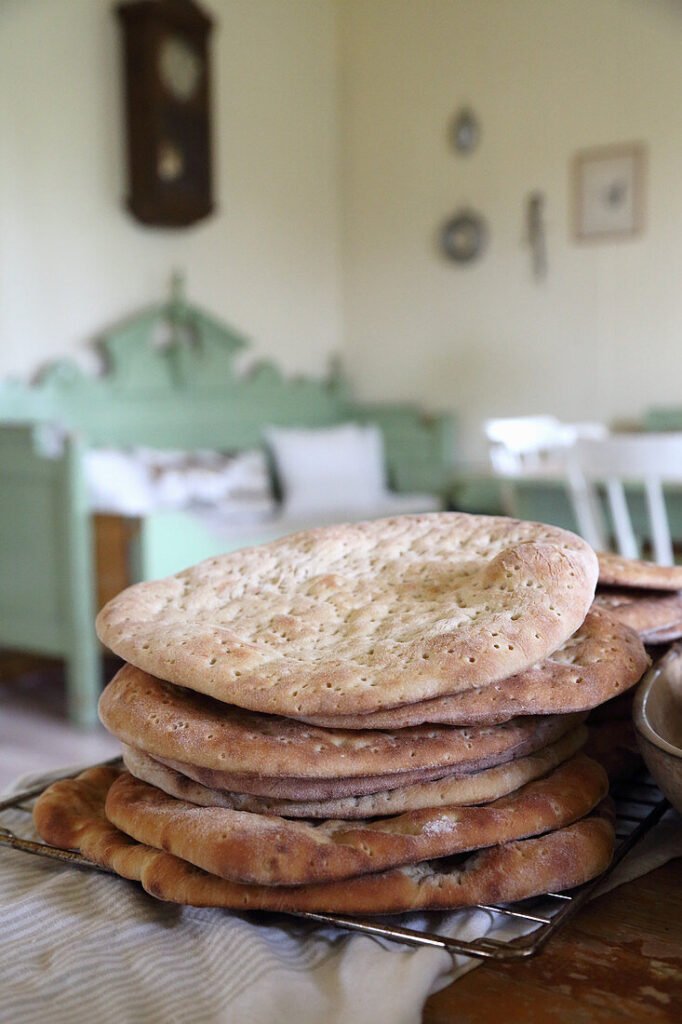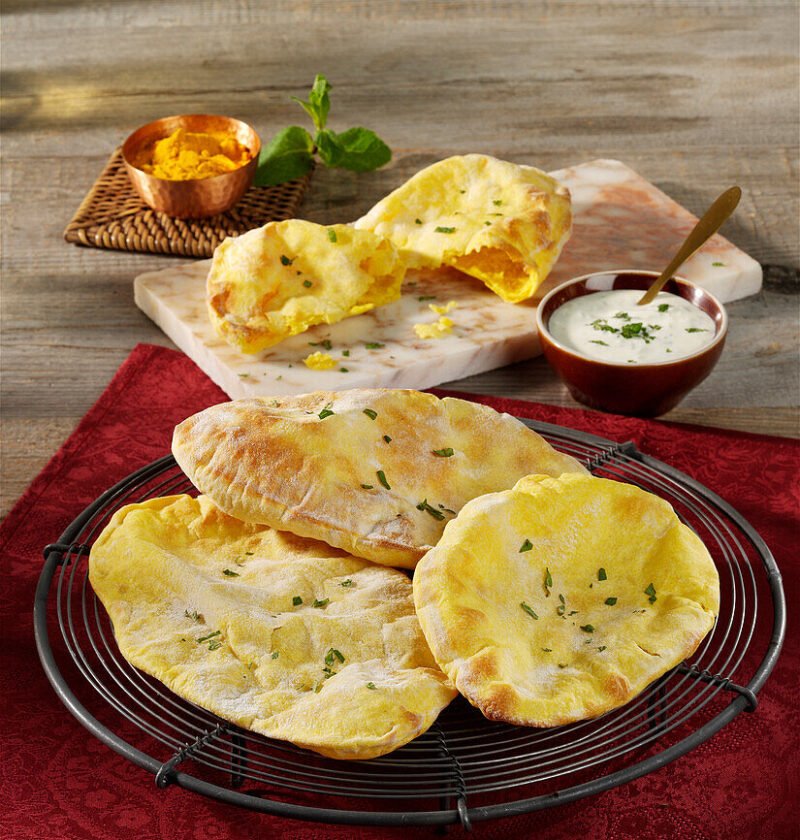Many people enjoy flatbread as a quick and tasty option, but they often wonder if it is healthy. The answer depends on the ingredients and how it is made. Flatbread can be a healthy choice with whole grains and limited added fat.
Some flatbreads are high in refined flour and salt, which may not be good for regular consumption. Others include fibre, vitamins, and minerals, making them a better option for a balanced diet.
What Is Flatbread?
Flatbread is a simple type of bread made with a few basic ingredients. It often cooks quickly because it is thin. Different styles and recipes vary by region and culture.
Different Types of Flatbread
Flatbread comes in many forms around the world. Popular types include tortilla from Mexico, naan from India, pita from the Middle East, and lavash from Armenia. Each has its own shape, thickness, and taste.
Some flatbreads are soft and chewy, like naan. Others are crisp and dry, like lavash. The cooking method, like baking or cooking on a griddle, also changes the texture.
Typical Ingredients in Flatbread
Flatbread usually has just a few main ingredients: flour, water, salt, and sometimes oil. Some recipes add yeast or baking powder to make them rise a little. Some flatbreads use wholegrain flours, which add more fibre and nutrients.
Oil, like olive or vegetable oil, often makes the bread softer. Salt adds flavour, but not too much. Simple ingredients make it easy to control what goes into the dough.
How Flatbread Is Made
Flatbread dough is made by mixing the ingredients until smooth. It is then rolled or pressed into flat shapes. After that, it cooks quickly on a hot surface like a griddle, oven, or open flame.
Some flatbreads, like naan, are baked in a tandoor or clay oven. Others cook on a pan or skillet. The cooking time is short, usually just a few minutes per side, because the bread is thin.
Nutritional Profile of Flatbread
Flatbread is mostly made from simple ingredients like flour, water, and sometimes oil or salt. It provides key nutrients such as carbohydrates, with varying amounts of protein, fats, vitamins, and minerals depending on the recipe and ingredients.
Macronutrients in Flatbread
Flatbread is mainly high in carbohydrates, which give energy. The amount varies, but is usually around 15-25 grams per small piece. It contains a moderate amount of protein, often 3-5 grams, coming from the flour used.
Fats in flatbread are generally low, typically less than 2 grams unless oil or butter is added. Whole wheat flatbread has slightly more protein and fibre than white flour versions.
Calories and Portion Sizes
A typical piece of flatbread has 70-120 calories, depending on size and ingredients. Smaller flatbreads made with plain flour are on the lower end of this scale.
Portion size matters since flatbreads can be thin or thick. Eating two or three small flatbreads adds up to 200-300 calories, which should be considered if counting energy intake.
Micronutrients and Fibre Content
Flatbread can contain small amounts of important vitamins and minerals like iron, calcium, and B vitamins, especially when made with whole grains.
Fibre content varies a lot. Whole wheat flatbread offers 2-4 grams of fibre per serving, which helps with digestion. White flour flatbread usually has less than 1 gram of fibre. The fibre amount depends on the type of flour used.
Also, Read
Health Benefits of Flatbread
Flatbread can be a good choice for those watching their diet, especially when made with whole grains or low-fat ingredients. It often has fewer calories and less fat compared to some other types of bread.
Wholegrain and High-Fibre Options
Flatbreads made from wholegrain flour provide more fibre than those made with white flour. Fibre helps with digestion and keeps people feeling full for longer, which can help with weight control.
Wholegrain flatbreads also contain important nutrients like B vitamins, iron, and magnesium. Choosing wholegrain flatbread instead of refined breads can improve heart health by lowering cholesterol levels.
People should check labels for “100% wholegrain” or “whole wheat” to get the most fibre and nutrients from flatbread.
Low-Fat Varieties
Many flatbreads are naturally low in fat because they use simple ingredients like flour, water, and a bit of salt. Some recipes add less oil or butter, keeping the fat content down.
Low-fat flatbreads make a good base for healthy toppings like vegetables, lean meats, or hummus without adding too many extra calories. This makes them useful for balanced meals.
They also tend to be easier to digest for those with sensitive stomachs or fat intolerances.
Nutritional Comparison to Other Breads
Compared to thicker breads like sandwich loaf or brioche, flatbread often has fewer calories per slice. This is partly because flatbreads are usually thinner and lighter.
Here’s a simple comparison of 100g portions:
| Bread Type | Calories | Fat (g) | Fibre (g) |
|---|---|---|---|
| White Flatbread | 250 | 3 | 2 |
| Wholegrain Flatbread | 230 | 2 | 6 |
| White Sandwich Bread | 270 | 4 | 1 |
Choosing wholegrain flatbread can offer a better balance of nutrients, including more fibre and less fat than many standard sandwich breads.
Potential Health Considerations
Flatbread can vary in its impact on health depending on its ingredients and how it is made. Some factors to watch for include gluten, salt, and added chemicals in store-bought versions.
Gluten Content and Sensitivities
Flatbread often contains wheat flour, which has gluten. People with coeliac disease must avoid gluten completely because it damages their intestines.
Others may have gluten sensitivity, which causes discomfort like bloating or stomach pain. For them, even small amounts of gluten can be a problem.
Gluten-free flatbreads are available and use flours like rice or chickpea. These options can be a safer choice for anyone avoiding gluten.
Sodium Levels
Packaged flatbreads sometimes have added salt to improve taste and shelf life. Eating too much salt can raise blood pressure and increase the risk of heart problems.
It’s good to check nutrition labels for sodium content. Some flatbreads have over 300 mg of sodium per serving, which is about 13% of the daily limit.
Low-sodium flatbreads are easier on the heart and better for people who watch their salt intake.
Additives and Preservatives in Packaged Flatbread
Many store-bought flatbreads include additives to keep bread fresh longer. These may include preservatives like calcium propionate.
Some might have emulsifiers or artificial flavours to improve texture and taste. While generally safe, some people prefer to avoid these chemicals.
Choosing flatbreads with simple ingredients — flour, water, yeast, and salt — means fewer unwanted extras. Homemade flatbread is often free of additives.

How to Make Flatbread a Healthier Choice
Choosing the right type of flatbread and paying attention to ingredients can improve its nutritional value. Making flatbread at home gives full control over what goes into it.
Choosing Wholemeal and Ancient Grain Flatbreads
Wholemeal flatbreads have more fibre and nutrients than white ones. Fibre helps with digestion and keeps people feeling full longer.
Ancient grains like spelt, quinoa, or rye offer extra vitamins and minerals. They also have lower glycaemic indexes, which means they release energy slowly.
Look for flatbreads labelled “100% whole grain” to get the best benefits. Avoid flatbreads with added sugars or lots of refined flour.
Reading Labels When Shopping
Check the ingredients list carefully. Shorter lists with recognisable items like flour, water, salt, and yeast are better.
Watch out for added sugars, preservatives, and hydrogenated fats. These can lower the health quality of flatbread.
Look at the nutrition facts for fibre, salt, and saturated fat. A good flatbread will have higher fibre and lower salt.
Homemade Flatbread Recipes
Making flatbread at home lets someone avoid unwanted additives. Basic flatbread needs only flour, water, salt, and sometimes a little oil.
Using wholemeal flour or mixing different grains can boost nutrition. It’s also possible to add seeds like flax or chia for extra fibre and omega-3.
Cooking flatbread on a dry pan or baking it in an oven keeps it low in calories. Homemade flatbread can be ready in less than an hour.
Best Ways to Enjoy Flatbread in a Balanced Diet
Flatbread can be a flexible part of meals when paired with the right ingredients. Choosing nutritious toppings and fresh sides helps keep the meal healthy and satisfying.
Healthy Toppings and Fillings
Choosing toppings with protein and fibre makes flatbread more filling and balanced. Options include grilled chicken, hummus, avocado, or low-fat cheese. Vegetables such as spinach, tomatoes, and peppers add vitamins without extra calories.
She can avoid heavy sauces that are high in sugar or fat. Instead, spreading a thin layer of olive oil or natural yoghurt adds flavour without overloading calories. Using fresh herbs like basil or coriander also boosts taste without extra salt.
Pairing Flatbread With Fresh Ingredients
Flatbread works well with fresh salads, raw vegetables, or fruit. Serving it alongside a mixed salad with greens, cucumber, and carrots adds crunch and nutrients. Adding a portion of fruit, such as apple slices, can provide natural sweetness and fibre.
He may also pair flatbread with soups or stews rich in vegetables and lean protein. This helps create a more balanced plate by combining grains with other food groups, avoiding empty calories or too much fat.

